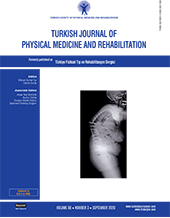A comparison of dry needling and kinesiotaping therapies in myofascial pain syndrome: A randomized clinical study
2 Department of Physical Medicine and Rehabilitation, Medicine Faculty of Atatürk University, Erzurum, Turkey
3 Department of Biostatistics, Medicine Faculty of Gaziosmanpaşa University, Tokat, Turkey DOI : 10.5606/tftrd.2020.3917 Objectives: This study aims to compare the effectiveness of dry needling (DN) and kinesiotaping (KT) therapies on pain, quality of life, depression, and physical function in the treatment of myofascial pain syndrome (MPS).
Patients and methods: The study included a total of 60 patients (4 males, 56 females; mean age 31.2±9.8 years; range, 18 to 56 years) diagnosed with MPS between January 2014 and June 2014. The patients were randomly divided into two treatment groups: the DN group (n=30) and KT group (n=30). Both groups performed stretching and postural exercises. The scales used for measurements were the Visual Analog Scale (VAS) for pain, a pressure algometer for the pressure-pain threshold, the Short Form-36 (SF-36) for the quality of life, Beck Depression Inventory (BDI) for depression, and the Neck Pain and Disability Scale (NPDS) for physical function. The patients were evaluated by a single assessor three times: pre-treatment, at the end of the treatment, and two months after the treatment.
Results: Both DN and KT provided significant improvements for all baseline measurements (VAS, pressure pain threshold, all subscales of SF-36, BDI, and NPDS scores) at the end of the treatment and two months after the treatment (p<0.05). However, there was no significant difference between the groups in all measurements (p>0.05).
Conclusion: Kinesiotaping is as an effective method as DN in the treatment of MPS. It can be served as a non-invasive alternative to patients with needle phobia.
Keywords : Disability, dry needling, kinesiotaping, myofascial pain syndrome, quality of life
















